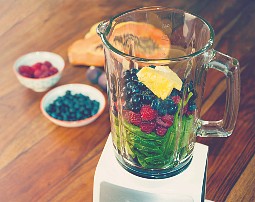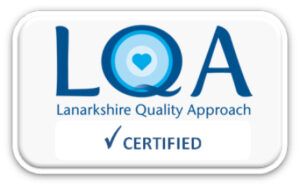Administration of Blended Diet via Gastrostomy
Information for patients
NHS Lanarkshire Neonatal Department
PIL.BLENDT.22_03607.L
Introduction
What is a Blended Diet?
Food and fluid that is liquidised to a consistency suitable to be given through a gastrostomy tube. This can be administered in addition or as a replacement to a prescribed formula/enteral feed.

Why Choose a Blended Diet?
There is limited research available to support the use of blended diet, however it has been shown to improve symptoms of vomiting, reflux and altered bowel habits.
In November 2019, the British Dietetic Association (BDA) released an updated policy statement:
“It is acknowledged that commercial formulas, irrespective of type or brand, are not tolerated by a small group of long-term tube-fed individuals. The reasons for this are not understood; the use of blended diet may provide clinical benefit in this patient group.”
Factors to consider for a Blended Diet
The dietitian will fully discuss with the parents/carers, the following factors when starting a blended diet:
- How to meet the child/young person’s nutritional requirements
- Food hygiene measures
- Potential for tube blockage
- Administering feed out with the home environment (i.e school/ respite)
- Contingency plan for periods of acute illness ( i.e. hospital admission) where provision of blended diet may not be possible
- Risk assessment to document agreed safety measures
Assessment
The dietitian and family will complete a pre-assessment and contract for patients starting a Blended Diet. The dietitian will also complete a checklist to ensure all the required tasks are completed and the appropriate support for the blended diet is in place. These documents will ensure that all services and parents are aware of the risks and measures put in place to minimise these.
What type of tube can be used to give Blended Diet?
Gastrstomy tubes should be 14Fr or larger. If the tube is less than 14Fr, careful consideration with the multidisciplinary team on the suitability of administration of blended diet via gastrstomy is required.
If this is a skin level (button) gastrostomy and it falls out it should be replaced if trained to do so. If there is Mic bolus Gastrostomy tube device (G-tube), parents/carers will be trained in how to manage a tube falling out. A spare tube, extension set and Enplug should be available with the child at all times.
Preparation and Storage of Blended Diet
Information on the appropriate food hygiene, preparation and storage of foods, including chilling, cleaning and cross-contamination can be found at:
Preparation of Blended Diet
- Foods chosen are required to meet the full nutritional requirements within the dietetic feeding regime
- Prepared blended foods should be prepared as close to the time of administering as possible
- Prepared blended foods should be cooked to 75 degrees then stored in the fridge when cooled
- Freshly prepared blended foods should be stored on the top shelf of the fridge between 0-5 degrees for no longer than 24 hours
- Blended foods can be split into portions and frozen on the day of preparation
- Foods should be defrosted in a container on the bottom shelf of a fridge
- Defrosted and leftover blended foods need to be reheated to 82 degrees and cooled to body temperature prior to administration
- Prepared blended foods should not remain at room temperature for more than 90 minutes
- A high-speed blender (above 1000 watts) is preferred as it will blend food to an appropriate consistency more easily than a hand blender. A sieve may also be required to ensure no lumps are in the blended food.
- Consistency should be IDDSI stage 3 (liquidised) (www.IDDSI.org). It is a smooth texture and drips slowly in dollops through the prongs of a fork
Parent/Carer Responsibilities
To ensure:
- An emergency supply of an easily administered/ stored/ transportable/ convenient substitute is available e.g. prescribed tube feed, pouches of smooth pureed infant food
- The substitute feed is in date
- The feed is of an agreed consistency and nutritional content
- The blended food is labelled with child’s name, date and time at which the food was prepared
- The feed is transported to school/care setting in a cool bag with an ice pack and refridgerated on arrival to school /care setting
School/Care Setting
- Blended diet can be provided and heated, if necessary as above guidance.
- Ensure feed is left at room temperature for 30 minutes prior to administering
- If there are any concerns in relation to the quality of the blended diet (i.e. fridge has broken / food has spoiled/ frozen foods not defrosted), not agreed consistency the individual administering the feed should administer the alternative feed and inform the parents
Procedure for administration of Blended Diet through a Skin Level Gastrostomy Tube (Button)
Items required for the procedure:
- 60ml enteral syringe
- Bolus extension set (wide bore)
- Blended feed at room temperature
- Cool boiled water for flushing
The Procedure
- Ensure everything you need has been collected and is near to hand.
- Inform the child that it is time for their feed.
- Position the child in a sitting position. If this is not possible their head should be elevated by at least one pillow.
- Wash and dry hands thoroughly.
- Prime extension set, by attaching a 60ml enteral syringe, pre-filled with cool boiled water, open the clamp and push the water through until extension set is full then close the clamp
- Shake the prepared blended feed thoroughly to ensure it is well mixed and of a thin pureed consistency.
- Fill 60ml enteral syringe/s with blended feed by pulling back on the plunger, ensuring no air is present.
- Remove the feeding port cover from the gastrostomy tube.
- Attach primed extension set to gastrostomy tube by matching the black lines on the extension set and the gastrostomy tube. Insert the extension set and rotate until you feel a slight resistance (approximately one quarter turn clockwise).
- Flush the gastrostomy tube by attaching a 60ml enteral syringe, pre-filled with the recommended amount of cool boiled water, open the clamp and administer the water by gentle pulsing pushes.
- Once the flush is complete close the clamp and remove the barrel of a 60ml enteral syringe.
- Commence feeding by attaching the blended feed pre filled 60ml enteral syringe, to the extension set and open the clamp.
- By gentle pulsing pushes administer the agreed blended feed, following dietetic feeding regime. This should take approximately 15-20 minutes depending on volume of feed.
- If may be necessary to give an additional flush of 10-20mls water if feed becomes difficult to administer.
- If the child/young person starts coughing or vomiting during the feed, then stop, and restart once they have settled. If they continue coughing or vomiting then call for advice.
- When the blended feed is complete, close the extension set clamp and remove the 60ml enteral syringe.
- Flush the gastrostomy tube by attaching a 60ml enteral syringe, pre-filled with the recommended amount of cool boiled water, open the clamp and administer the water by gentle pulsing pushes.
- Once the flush is complete, close the clamp and remove extension set by rotating anti-clockwise until the black lines match. Replace feeding port cover.
- Wash and store extension set and reusable 60ml enteral syringe as per manufacturers instructions.
- Wash and dry hands thoroughly.
Procedure for administration of Blended Diet through a Percutaneous Endoscopic Gastrostomy/MIC Bolus Gastrostomy Feeding tube
Items required for the procedure:
- 60ml enteral syringe
- Blended feed at room temperature
- Cool boiled water for flushing
The Procedure
1. Ensure everything you need has been collected and is near to hand.
2. Inform the child that it is time for their feed.
3. Position the child in a sitting position. If this is not possible their head should be elevated by at least one pillow.
4. Wash and dry hands thoroughly.
5. Shake the prepared blended feed thoroughly to ensure it is well mixed and of a thin pureed consistency.
6. Fill 60ml enteral syringe/s with blended feed by pulling back on the plunger, ensuring no air is present.
7. Ensure the clamp on the gastrostomy tube is closed and remove the stopper from the end of the gastrostomy tube.
8. Flush the gastrostomy tube by attaching a 60ml enteral syringe, pre-filled with the recommended amount of cool boiled water, open the clamp and administer the water by gentle pulsing pushes.
9. Once the flush is complete close the clamp and remove the 60ml enteral syringe.
10. Commence feeding by attaching the blended diet pre-filled 60ml enteral syringe to the gastrostomy tube and open the clamp.
11. By gentle pulsing pushes, administer the agreed blended feed following dietetic feeding regime. This should take approximately 15-20 minutes depending on volume of feed.
12. If feed becomes difficult to administer or the tube blocks, give an additional flush of 10-20mls water to clear the tube and then continue with the remaining feed.
13. If the child starts coughing or vomiting during the feed, then stop, and restart once they have settled. If they continue coughing or vomiting then call for advice
14. When the blended feed is complete, close the clamp and remove the 60ml enteral syringe.
15. Flush the gastrostomy tube by attaching a 60ml enteral syringe, pre-filled with the recommended amount of cool boiled water, open the clamp and administer the water by gentle pulsing pushes.
16. Once the flush is complete, close the clamp, remove syringe and replace stopper.
17. Wash and store the reusable 60ml enteral syringe as per manufacturer’s instructions.
Frequently Asked Questions
1. What should be done if the gastrostomy tube falls out?
If the gastrostomy tube falls out DO NOT panic, the gastrostomy site will not close over immediately. If you have been taught to insert a gastrostomy tube, then follow the procedure to reinsert a new tube.
If you have not been shown, cover the stoma site with a clean dressing to soak any leakage of fluid from the stomach.
Contact the child’s parent/carer or Community Children’s Nursing Service to replace tube. If no reply attend hospital as early replacement is essential.
2. What should be done if the gastrostomy tube blocks?
If the gastrostomy tube blocks clean the feeding port with water and cotton tipped applicator, then try flushing the gastrostomy tube again. If this doesn’t work attempt to flush the gastrostomy tube with warm water and leave for 30 minutes.
DO NOT use excessive pressure when flushing. If this method fails call for advice.
3. What should be done if there is a blockage in the extension tube?
If you are unable to flush the extension set replace with a new one.
A note of advice
Gastrostomy tubes and extension sets do occasionally block. This is often caused by medicines or feed accumulating in the tube. To help prevent this ALWAYS FLUSH the tube before and after each feed/ medication with cool boiled water.
4. What should be done if the child/young person is bloated or retching?
This can be relieved by attaching an extension set and the barrel of a 60ml enteral syringe, open the clamp and this will release air/food from the stomach.
5. How do I clean syringes?
The syringes, in the community, are reusable. After each use, syringes should be cleaned with liquid detergent, rinsed, air dried and stored in a clean, dry container.
Each syringe should be discarded if markings are no longer visible, are stiff to push or have been in use for 14 days.
6. How do I clean the extension sets?
Extension sets are reusable and after each use, should be cleaned with liquid detergent, rinsed, air dried and stored in a clean, dry container.
Each extension set should be discarded after 14 days use or if any signs of damage.
Review date: March 2024
Issue No: 01a
Reference: PIL.BLENDT.22_03607.L
If you need this information in another language or format, please e-mail:




